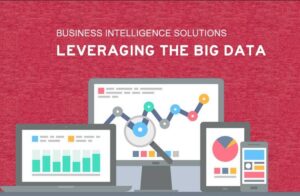Introduction
With the advent of technology, the amount of data generated by businesses has grown exponentially. Big data refers to large, complex data sets that can be analyzed to reveal patterns and trends, which can be used for business intelligence. Business intelligence (BI) refers to the strategies, technologies, and tools used to collect, analyze, and present data in order to make informed business decisions. Leveraging big data for business intelligence can help businesses gain a competitive advantage and make data-driven decisions. In this article, we will explore strategies and tools that businesses can use to leverage big data for business intelligence.

Strategies for Leveraging Big Data
Define Business Objectives
Before collecting and analyzing data, businesses should define their business objectives. Defining business objectives will help businesses identify what data to collect and how to analyze it. Business objectives can be in the form of questions that need to be answered. For example, a business objective could be to increase sales. The question that needs to be answered is, “What factors are affecting sales?”
Collect Relevant Data
Once business objectives have been defined, businesses should collect relevant data. The data collected should be relevant to the business objectives. Data can be collected from internal sources such as customer databases, sales data, and financial data. Data can also be collected from external sources such as social media, government data, and industry reports.
Clean and Organize Data
Once data has been collected, it should be cleaned and organized. Data cleaning refers to the process of identifying and correcting errors and inconsistencies in data. Data organization refers to the process of arranging data in a way that makes it easy to analyze. Data cleaning and organization are important because they ensure that data is accurate and can be easily analyzed.
Analyze Data
Once data has been cleaned and organized, it should be analyzed. Data analysis involves using statistical methods and machine learning algorithms to identify patterns and trends in the data. Data analysis can help businesses identify opportunities and threats, and make data-driven decisions.
Visualize Data
Once data has been analyzed, it should be visualized. Data visualization refers to the process of presenting data in a graphical or pictorial form. Data visualization can help businesses understand patterns and trends in the data. Data visualization can also help businesses communicate insights to stakeholders.
Tools for Leveraging Big Data
Hadoop
Hadoop is an open-source software framework for storing and processing big data. Hadoop allows businesses to store and process large amounts of data across clusters of computers. Hadoop is scalable, fault-tolerant, and cost-effective. Hadoop is used by many businesses to store and process big data.
Spark
Spark is an open-source software framework for processing big data. Spark is faster and more efficient than Hadoop. Spark can process data in-memory, which makes it faster than Hadoop. Spark is used by many businesses to process big data.
Tableau
Tableau is a data visualization software that allows businesses to create interactive and dynamic visualizations of their data. Tableau can connect to many different data sources, including big data sources. Tableau is used by many businesses to visualize their big data.
Python
Python is a programming language that is widely used for data analysis and machine learning. Python has many libraries and frameworks that make it easy to analyze big data. Python is used by many businesses to analyze big data.
FAQ
What is big data?
Big data refers to large, complex data sets that can be analyzed to reveal patterns and trends.
What is business intelligence?
Business intelligence (BI) refers to the strategies, technologies, and tools used to collect, analyze, and present data in order to make informed business decisions.
Why is leveraging big data for business intelligence important?
Leveraging big data for business intelligence is important because it allows businesses to gain insights and make data-driven decisions. By analyzing large amounts of data, businesses can identify patterns and trends that would be difficult or impossible to identify manually. This can help businesses make informed decisions and gain a competitive advantage.
What are some challenges of leveraging big data for business intelligence?
One challenge of leveraging big data for business intelligence is data quality. Big data can be messy and contain errors and inconsistencies. Another challenge is data security. Big data can contain sensitive information that needs to be protected. Finally, there is a shortage of skilled data analysts and data scientists who can analyze big data.
How can businesses overcome these challenges?
To overcome these challenges, businesses should invest in data quality management tools and processes. Businesses should also invest in data security tools and processes to protect sensitive data. Finally, businesses can invest in training and hiring skilled data analysts and data scientists.
Conclusion
Leveraging big data for business intelligence can help businesses gain a competitive advantage and make informed decisions. By defining business objectives, collecting relevant data, cleaning and organizing data, analyzing data, and visualizing data, businesses can gain insights and make data-driven decisions. By using tools such as Hadoop, Spark, Tableau, and Python, businesses can store, process, analyze, and visualize big data. However, there are also challenges to leveraging big data for business intelligence, such as data quality and security, and a shortage of skilled data analysts and data scientists. By investing in data quality management tools and processes, data security tools and processes, and training and hiring skilled data analysts and data scientists, businesses can overcome these challenges and leverage big data for business intelligence.
